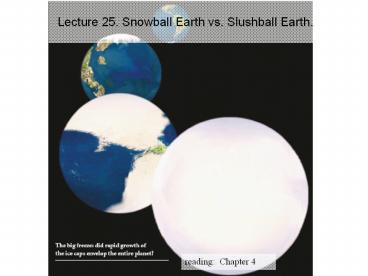Lecture 25. Snowball Earth vs. Slushball Earth.. - PowerPoint PPT Presentation
1 / 17
Title:
Lecture 25. Snowball Earth vs. Slushball Earth..
Description:
Lecture 25. Snowball Earth vs. Slushball Earth.. reading: Chapter 4 In 1964, Brian Harland at Cambridge Univ. noticed Neoproterozoic glacial deposits were widely ... – PowerPoint PPT presentation
Number of Views:341
Avg rating:3.0/5.0
Title: Lecture 25. Snowball Earth vs. Slushball Earth..
1
Lecture 25. Snowball Earth vs. Slushball Earth..
reading Chapter 4
2
Early Observations
In 1964, Brian Harland at Cambridge Univ. noticed
Neoproterozoic glacial deposits were widely
distributed on nearly every continent Geologic
evidence suggested glaciation at low
latitudes Mikhail Budyko at Leningrad
Geophysical Observatory worked on climate
modeling discovered that ice-albedo feedback
caused instability in climate
3
Ice-Albedo Feedback
Albedo 0.1 seawater 0.3 bare land 0.6 sea
ice 0.9 fresh snow
As Earth cools 1. Ice forms at lower and lower
latitudes 2. Albedo rises 3. Reflects more
solar radiation 4. Cools even more (positive
feedback loop) Once ice formed at a critical
latitude (30) the positive feedback so strong
that T plummets Creates a completely frozen
planet. Geothermal heat keeps oceans from
freezing completely, so ice 1km thick on average.
4
A Permanent Catastrophe?
Would have already extinguished
life. Temperatures would have been -50C. No
means of escape. In 1977 Discovery of
hydrothermal vents. Discovery of dry valleys of
Antarctica - organisms can live in extremely
cold environments. Appreciation for life in
extreme environments. also discovery of plate
tectonics
5
Evidence of Glaciation
Glaciers carry large stones - when the glaciers
melt, they leave dropstones. Characteristic of
glaciers.
6
Glaciation at Low Latitudes (Near Equator)
Paleomagnetism When sediments form magnetic
minerals point to the N pole. At the equator
they will point horizontally at the
equator. Found that glacial rocks in the
Neoproterozoic had horizontal magnetic
properties. Suggests glacial deposits occurred
at low latitudes.
7
Other Evidence of Large Scale Change
The return of banded iron formation in marine
waters What do you need have have BIF? Lots of
Fe2 - Little O2 Suggests oceans cut off from the
atmosphere - ice??
8
Other Evidence of Large Scale Change, cont.
9
When Do We Have BIF?
10
How To Reverse a Snowball Event?
In late 1980s, Joe Kirschvink of CalTech Gave it
the name Snowball Earth. Showed that the CO2
supply would continue BUT it would be so cold
that there is no liquid water at the
surface. Weathering reactions stop, sloooooow
dooooowwwwn. What happens then?
11
How To Reverse a Snowball Event?
Estimated 350x present level of CO2 needed to
overcome the albedo of the Snowball Earth. Would
have taken several million years for this much
CO2 to accumulate. CO2 causes warming, which
begins melting. As melting occurs what happens
to the albedo? What does this do? Melting would
have been catastrophic - sea ice gone in few
hundred years. Sea level rises dramatically! As
soon as the ice is gone, it gets hot!!
12
The Following Hot House
After the Snowball, now have a hot house. How
hot? 50C!! Have a CO2-rich atmosphere, warm
conditions. What happens next??
13
The Carbonate-Silicate Cycle Kicks Into High Gear!
- CO2 outgassing from volcanoes (greenhouse gas)
- CO2 dissolves in rain, lakes, streams, turns into
carbonic acid - Carbonic acid reacts with rocks, making ions,
quartz, and clay - Ions and dissolved CO2 reacts to make carbonate
rocks - Carbonate rocks are subducted
- Subducted carbonate rocks turned into CO2
Extremely acidic rain. Rapid weathering of
rocks. Since it is warm, we should make
_____________ carbonate rocks.
14
Evidence of a Hot House
Huge, thick carbonate rock over layers of glacial
deposits - called cap carbonates - is evidence
that they were formed very rapidly - few hundred
yrs
15
Snowball Earths During Critical Geologic Times
2.3 Ga - right as oxygen becomes present in the
atmosphere 3 or 4 glacial events within a
relatively short period of time. Neoproterozoic
- animal embryo and early sponges in
between glacial events. Thought to be 3 glacial
events. Both are associated with increases in
oxygen.
16
Why Only One Snowball Event on the Early Earth?
- Faint Young Sun - expect more glacial events in
the Archean and - Paleoproterozoic!
- Geologic evidence of an early CO2-rich atmosphere
- Also evidence for an early CH4-rich atmosphere
- CH4 is easily oxidized to CO2
- But CH4 is a stronger greenhouse gas
- Oxygen in the atmosphere destroyed the CH4
greenhouse - Catastrophic entrance into a Snowball episode
17
Lecture 26. Exploration, the Federal and NASA
Budgets, and Politics.
reading none - budget documents on the web site































